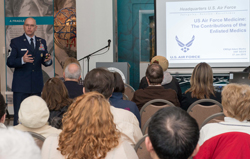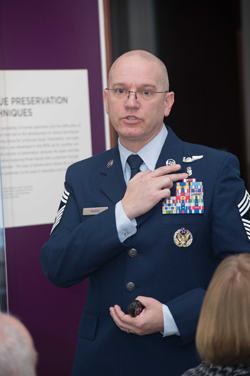Extensive training crucial for aspiring medics
By Paul Bello, National Museum of Health and Medicine
SILVER SPRING, Md. - The National Museum of Health and Medicine's (NMHM) monthly Medical Museum Science Café moved to the museum's galleries in January, allowing attendees the opportunity to view artifacts and specimens connected to the lecture. The series of informal talks that connect the Department of Defense medical museum with the public started 2015 with a look at U.S. Air Force medicine.
Chief Master Sgt. Adam H. Marks, Chief of Medical Operations and Research for the U.S. Air Force Surgeon General, gave a presentation entitled, "Air Force Medicine: The Contributions of the Enlisted Medic."
According to Marks, there are approximately 20,000 enlisted medics, or technicians, in the Air Force today. That group is dispersed among 17 different career fields that include, among others, health service management, biomedical equipment, mental health, diagnostic imaging and aerospace medical service, Marks' career field since joining the Air Force 28 years ago.
"With the right seasoning, we're confident our Airmen will be successful at any field chosen. Advanced training can only lead to more specialized areas," Marks said. "Training includes being able to spend time in an emergency room, or on the floor of an OBGYN, or even working in the medical surgery division of a major hospital. The goal here is for our technicians to accomplish certain tasks before being assigned to their first duty station."
The Air Force has put a lot of time and resources into making sure technicians are properly trained and ready to step in wherever needed, Marks said. Testament to this was their response during Operation Tomodachi, where U.S. service members supported the Japanese disaster relief effort following the 2011 Tohoku earthquake and tsunami.
As first responders, Air Force bioenvironmental engineers determined radiation levels for safe drinking water in Japan, as well as surrounding countries. More than 70 percent of the DoD Radiation Assessment Team assigned to this effort was, in fact, enlisted medics supporting bioenvironmental engineers, according to Marks.
"The enlisted corps is the backbone of our Air Force. I don't think anyone is denying that," Marks said. "We have many far reaching responsibilities to make sure we're meeting our nation's obligations, particularly when we're overseas. This was a great example of that."
Marks, who flew air evacuation missions during the wars in Iraq and Afghanistan, at one time worked in the intensive care unit of the Prince Georges Medical Center. He concluded his presentation with some words to those interested in a career in health, science or emergency response. His best advice, he says, is actually quite simple.
"I always tell people to take pride in their work and don't do anything twice," Marks said while smiling. "Do it once and do it right. If you do that, you'll be just fine."
The 2015 Medical Museum Science Café series continues in February with "Vietnam War Medicine: A Look at the Medical Museum, 2nd Surgical Hospital." Dr. Norman Rich, a retired Army colonel and renowned vascular surgeon will speak about his experiences as a surgeon during the Vietnam War and guests can see artifacts from his traveling museum that have been donated to NMHM. The February Science Café will be held Feb. 24, 2015 at 6 p.m. at the National Museum of Health and Medicine, 2500 Linden Lane, Silver Spring, MD. For more information, visit www.medicalmuseum.mil.

|
Caption: Chief Master Sgt. Adam H. Marks, Chief, Medical Operations and Research, Office of the U.S. Air Force Surgeon General, discusses the training involved with becoming an Air Force medic during a presentation at the National Museum of Health and Medicine’s monthly Medical Museum Science Café January 27, 2015. (Disclosure: This image has been cropped to emphasize the subject.) (National Museum of Health and Medicine photo by Matthew Breitbart/ Released) |

|
Caption: Chief Master Sgt. Adam H. Marks, Chief, Medical Operations and Research, Office of the U.S. Air Force Surgeon General, points to his Air Force medic badge during his presentation at the National Museum of Health and Medicine’s monthly Medical Museum Science Café January 27, 2015. (Disclosure: This image has been cropped to emphasize the subject.) (National Museum of Health and Medicine photo by Matthew Breitbart/ Released) |



